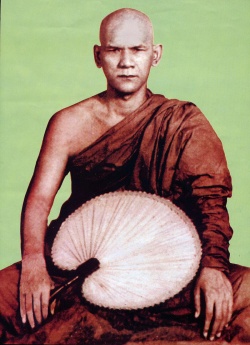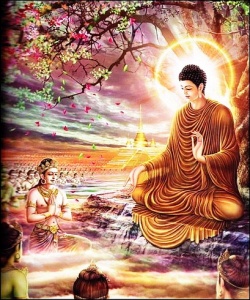Difference between revisions of "Mahasi Sayadaw"
| Line 1: | Line 1: | ||
[[File:Mahasi Sayadaw.jpg|thumb|250px|]] | [[File:Mahasi Sayadaw.jpg|thumb|250px|]] | ||
| + | |||
| + | |||
| + | |||
| + | |||
<poem> | <poem> | ||
| − | [[Mahasi Sayadaw U Sobhana]] ([[Burmese]]: မဟာစည်ဆရာတော် ဦးသောဘန, pronounced: [məhàsì sʰəjàdɔ̀ ʔú θɔ́bəna̰]; 29 July 1904 – 14 August 1982) was a [[Burmese]] [[Theravada]] [[Buddhist monk]] and [[meditation]] [[master]] who had a significant impact on the [[teaching]] of [[Vipassana]] ([[Insight]]) [[meditation]] in the [[West]] and throughout {{Wiki|Asia}}. In his style of practice, derived from the so-called "New [[Burmese]] Method" of [[U Nārada]], the [[meditator]] anchors their [[attention]] on the [[sensations]] of the rising and falling of the {{Wiki|abdomen}} during {{Wiki|breathing}}, observing carefully any other [[sensations]] or [[thoughts]]. | + | [[Mahasi Sayadaw U Sobhana]] ([[Burmese]]: မဟာစည်ဆရာတော် ဦးသောဘန, pronounced: [məhàsì sʰəjàdɔ̀ ʔú θɔ́bəna̰]; 29 July 1904 – 14 August 1982) was a [[Burmese]] [[Theravada]] [[Buddhist monk]] and [[meditation]] [[master]] who had a significant impact on the [[teaching]] of [[Vipassana]] ([[Insight]]) [[meditation]] in the [[West]] and throughout {{Wiki|Asia}}. |
| + | |||
| + | In his style of practice, derived from the so-called "New [[Burmese]] Method" of [[U Nārada]], the [[meditator]] anchors their [[attention]] on the [[sensations]] of the rising and falling of the {{Wiki|abdomen}} during {{Wiki|breathing}}, observing carefully any other [[sensations]] or [[thoughts]]. | ||
{{Wiki|Biography}} | {{Wiki|Biography}} | ||
| − | [[Mahāsi Sayādaw]] was born in 1904 in Seikkhun village in Upper [[Burma]]. He became a [[novice]] at age twelve, and was [[ordained]] at the age of twenty with the [[name]] [[Sobhana]]. Over the course of decades of study, he passed the rigorous series of government examinations in the [[Theravāda]] [[Buddhist texts]], gaining the newly-introduced [[Dhammācariya]] ([[dhamma | + | [[Mahāsi Sayādaw]] was born in 1904 in Seikkhun village in Upper [[Burma]]. He became a [[novice]] at age twelve, and was [[ordained]] at the age of twenty with the [[name]] [[Sobhana]]. |
| + | |||
| + | Over the course of decades of study, he passed the rigorous series of government examinations in the [[Theravāda]] [[Buddhist texts]], gaining the newly-introduced [[Dhammācariya]] ([[dhamma teacher]]) [[degree]] in 1941. | ||
[[File:Preaching.JPG|thumb|250px|]] | [[File:Preaching.JPG|thumb|250px|]] | ||
| − | In 1931, | + | In 1931, [[U Sobhana]] took leave from [[teaching]] [[scriptural]] studies in [[Moulmein]], [[South]] [[Burma]], and went to nearby [[Thaton]] to practice intensive [[Vipassana]] [[meditation]] under [[Mingun Jetawun Sayādaw]] (also rendered [[Mingun Jetavana Sayādaw]]), also known as [[U Nārada]]. |
| + | |||
| + | |||
| + | This [[teacher]] had practiced in the remote [[Sagaing]] Hills of Upper [[Burma]], under the guidance of [[Aletawya Sayādaw]], a [[student]] of the {{Wiki|forest}} [[meditation]] [[master]] [[Thelon Sayādaw]]. | ||
| + | |||
| + | [[U Sobhāna]] first [[taught]] [[Vipassana]] [[meditation]] in his [[home]] village in 1938, at a [[monastery]] named for its massive [[drum]] '[[Mahāsi]]'. | ||
| + | |||
| + | He became known in the region as [[Mahāsi Sayādaw]]. | ||
| + | |||
| + | In 1947, the Prime [[Minister]] of [[Burma]], [[U Nu]], invited [[Mahāsi Sayādaw]] to be resident [[teacher]] at a newly established [[meditation]] center in {{Wiki|Yangon}}, which came to be called the [[Mahāsi Sāsana Yeiktha]. | ||
| + | |||
| + | [[Mahāsi Sayādaw]] was a questioner and final editor at the [[Sixth Buddhist Council]] on May 17, 1954. | ||
| + | |||
| + | He helped establish [[meditation]] centers all over [[Burma]] as well as in [[Sri Lanka]], {{Wiki|Indonesia}}, [[Thailand]], and by 1972 the centers under his guidance had trained more than 700,000 [[meditators]]. | ||
| + | |||
| + | In 1979, he travelled to the [[West]], [[holding]] [[retreats]] at newly founded centers such as the [[Insight]] [[Meditation]] {{Wiki|Society}} (IMS) in Barre, {{Wiki|Massachusetts}}, [[U.S.]] | ||
| + | |||
| + | In addition, [[meditators]] came from all over the [[world]] to practice at his center in {{Wiki|Yangon}}. | ||
| − | + | When the [[Mahāsi Sayādaw]] [[died]] on 14 August 1982 following a massive stroke, thousands of {{Wiki|devotees}} braved the torrential {{Wiki|monsoon}} rains to pay their last respects. | |
Notable students | Notable students | ||
| Line 16: | Line 41: | ||
G. V. Desani | G. V. Desani | ||
{{Wiki|Joseph Goldstein}} | {{Wiki|Joseph Goldstein}} | ||
| − | [[Anagarika]] | + | [[Anagarika Munindra]] |
| − | + | [[Achan Sobin S. Namto | |
| − | Sayādaw U | + | [[Sayādaw U Paṇḍita]] (Panditārāma) |
{{Wiki|Sharon Salzberg}} | {{Wiki|Sharon Salzberg}} | ||
| − | Chanmyay Sayādaw (U [[Janakabhivamsa]]) | + | [[Chanmyay Sayādaw]] (U [[Janakabhivamsa]]) |
Rodney Smith | Rodney Smith | ||
[[Ashin Jinarakkhita]] | [[Ashin Jinarakkhita]] | ||
| Line 26: | Line 51: | ||
Publications | Publications | ||
| − | [[Mahāsi Sayādaw]] published nearly seventy volumes of [[Buddhist]] {{Wiki|literature}} in [[Burmese]], many of these transcribed from talks. He completed a [[Burmese]] translation of the [[Visuddhimagga]], ("The [[Path | + | [[Mahāsi Sayādaw]] published nearly seventy volumes of [[Buddhist]] {{Wiki|literature}} in [[Burmese]], many of these transcribed from talks. |
| + | |||
| + | He completed a [[Burmese]] translation of the [[Visuddhimagga]], ("The [[Path of Purification]]") a lengthy treatise on [[meditation]] by the 5th century [[Indian]] [[Theravadin]] [[Buddhist]] commentator and [[scholar]] [[Buddhaghosa]]. He also wrote a volume entitled Manual of [[Vipassana]] [[Meditation]]. His English works include: | ||
Practical [[Vipassana]] Exercises | Practical [[Vipassana]] Exercises | ||
| − | [[Satipatthana | + | [[Satipatthana Vipassana Meditation]] |
The Progress of Insight—an advanced talk on [[Vipassana]] | The Progress of Insight—an advanced talk on [[Vipassana]] | ||
[[Thoughts]] on the [[Dharma]] | [[Thoughts]] on the [[Dharma]] | ||
Latest revision as of 14:05, 16 November 2015
Mahasi Sayadaw U Sobhana (Burmese: မဟာစည်ဆရာတော် ဦးသောဘန, pronounced: [məhàsì sʰəjàdɔ̀ ʔú θɔ́bəna̰]; 29 July 1904 – 14 August 1982) was a Burmese Theravada Buddhist monk and meditation master who had a significant impact on the teaching of Vipassana (Insight) meditation in the West and throughout Asia.
In his style of practice, derived from the so-called "New Burmese Method" of U Nārada, the meditator anchors their attention on the sensations of the rising and falling of the abdomen during breathing, observing carefully any other sensations or thoughts.
Biography
Mahāsi Sayādaw was born in 1904 in Seikkhun village in Upper Burma. He became a novice at age twelve, and was ordained at the age of twenty with the name Sobhana.
Over the course of decades of study, he passed the rigorous series of government examinations in the Theravāda Buddhist texts, gaining the newly-introduced Dhammācariya (dhamma teacher) degree in 1941.
In 1931, U Sobhana took leave from teaching scriptural studies in Moulmein, South Burma, and went to nearby Thaton to practice intensive Vipassana meditation under Mingun Jetawun Sayādaw (also rendered Mingun Jetavana Sayādaw), also known as U Nārada.
This teacher had practiced in the remote Sagaing Hills of Upper Burma, under the guidance of Aletawya Sayādaw, a student of the forest meditation master Thelon Sayādaw.
U Sobhāna first taught Vipassana meditation in his home village in 1938, at a monastery named for its massive drum 'Mahāsi'.
He became known in the region as Mahāsi Sayādaw.
In 1947, the Prime Minister of Burma, U Nu, invited Mahāsi Sayādaw to be resident teacher at a newly established meditation center in Yangon, which came to be called the [[Mahāsi Sāsana Yeiktha].
Mahāsi Sayādaw was a questioner and final editor at the Sixth Buddhist Council on May 17, 1954.
He helped establish meditation centers all over Burma as well as in Sri Lanka, Indonesia, Thailand, and by 1972 the centers under his guidance had trained more than 700,000 meditators.
In 1979, he travelled to the West, holding retreats at newly founded centers such as the Insight Meditation Society (IMS) in Barre, Massachusetts, U.S.
In addition, meditators came from all over the world to practice at his center in Yangon.
When the Mahāsi Sayādaw died on 14 August 1982 following a massive stroke, thousands of devotees braved the torrential monsoon rains to pay their last respects.
Notable students
Freda Bedi
G. V. Desani
Joseph Goldstein
Anagarika Munindra
[[Achan Sobin S. Namto
Sayādaw U Paṇḍita (Panditārāma)
Sharon Salzberg
Chanmyay Sayādaw (U Janakabhivamsa)
Rodney Smith
Ashin Jinarakkhita
Publications
Mahāsi Sayādaw published nearly seventy volumes of Buddhist literature in Burmese, many of these transcribed from talks.
He completed a Burmese translation of the Visuddhimagga, ("The Path of Purification") a lengthy treatise on meditation by the 5th century Indian Theravadin Buddhist commentator and scholar Buddhaghosa. He also wrote a volume entitled Manual of Vipassana Meditation. His English works include:
Practical Vipassana Exercises
Satipatthana Vipassana Meditation
The Progress of Insight—an advanced talk on Vipassana
Thoughts on the Dharma

